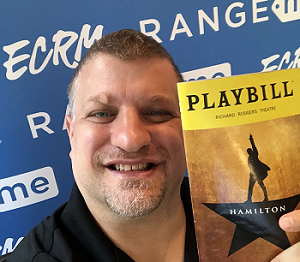Alexander Hamilton and the Power of Content for Retailers and Brands 6/1/2018
I recently had the privilege of seeing the musical Alexander Hamilton on Broadway (4th row, orchestra -- please don't hate), and prior to the show, I also read the massive biography by Ron Chernow, which was Lin Manuel Miranda's inspiration for the play.
One thing that stood out from the experience was just how large a role content played in most of Hamilton's accomplishments. He authored the largest share of The Federalist Papers, which were the foundation on which our country's constitution was based; the four reports he wrote as Treasury secretery -- on public credit, the formation of a national bank, on the constitutionality of the Bank of the United States, and on manufacturing -- were the basis of the U.S. economy; and the hundreds of newspaper columns he published helped support various causes and political allies. Indeed, he was a content marketing machine.
Today, content is no less important. The only difference is that there is so much more of it out there, and so many ways in which we can get it out to our intended audience, and for retailers and brands, content can make the difference between whether a consumer buys your product or shops in your store, or buys from a competitor.

There are three key components of successful content marketing: creating value, consistent delivery and smart distribution. I'll address each of these components below.
Creating Value
Perhaps the most important of the three is creating content that is valuable for your intended audience, which as a retailer or brand, is your current customers and prospective customers (and for brands, these customers should be both consumers and retailers). And the easiest way of determining what is valuable to them is by asking them, or rather, listening to them and the questions they ask of you. The answers that you would typically give to them can each be turned into a piece of content.
This column is an example. It came about after a discussion about content development I had with a supplier, who asked me for advice on how to approach their content marketing. If you are a grocery retailer, a consumer may ask what are some good plant-based products that they can incorporate into a summer barbecue -- the answer to that would make a great blog post. ("Vegans - 10 Must-Have Products for a Plant-Based BBQ"). Or, maybe you are a supplier of skin care products, and someone with a particular skin issue or allergy is looking for the best types of products that won't irritate their skin. Basically, the answer to any question your customers may ask can be repurposed into a piece of content, whether a blog post, a how to video, a tweet, etc.
What delivering value doesn't mean is shoving promotions down your audience's throat every day. This doesn't build trust. I follow Gary Vaynerchuk's philosophy here, which was outlined in his book, Jab, Jab, Jab, Right Hook. Most of your content should deliver value without asking anything in return. Then, once you build up their trust with the "jabs," it's okay to throw in the occasional ask -- the "right hook."
Consistent Delivery
Regardless of how great your content is, if you don't deliver fresh, valuable content on a regular basis, you're not going to build the trust and loyalty of your audience. By developing a regular content schedule, your audience knows that they can come to you again and again for their information needs, and what's more, when they are ready to make a purchase, you will be top-of-mind when they decide where to go. So set up a regular schedule of content, one that is not overwhelming but also leaves room for spur-of-the-moment content pieces (like this one) if inspiration strikes.
Remember, content marketing is a marathon, not a sprint; consistent content delivery over the long term is what will build trust and engagement with your audience.
Smart Distribution
Ok, you've outlined some great topics and put together a regular schedule for their delivery. Now the question is, how will you distribute your content? Again, turn to your intended audience for your answer. Evaluate how, when, and where they are consuming content, and those are the areas in which you want to play.
First off, you want to have your home base -- the one area to which most of your content drives the audience. In most cases, this will be a blog on your website. This is where you can capture their information by asking them to sign up for a newsletter, and where the bulk of your content will be posted. All of the content you distribute -- whether via a newsletter, social media, YouTube videos -- should lead them to your website.
Next, you want to share this content wherever your customers are. For us at ECRM, we have our blog and email newsletter, but we also share content on social media sites, particularly on LinkedIn, as we are a B2B company, and our audience is very active on that platform. And the type of content on social media varies from simple posts linking back to a blog, to native videos that may link to a particular page on our website that we are promoting. We'll also participate in outside industry podcasts that address our audience, and work with trade media brands that cover our markets.
The key here is, you want to tailor the content delivery to your audience. If you're a beauty brand and you are aiming at consumers, instagram is a great platform because it's very visual. If you are a grocer sharing recipe tips, Facebook may be a great platform, particularly within groups that focus on food. YouTube is a great platform as well.
One note about video. Video is huge, and if you are not developing video content, you are missing out. These don't have to be fancy -- most of our videos are shot and edited with mobile phones. But people are increasingly consumeing video content, especially from their mobile devices, so you want to make sure you have some sort of video component in your content efforts. Podcasts are becoming very popular as well, so you definitely should explore that medium, as well. And if you don't want to invest time in creating your own, you can look to participate in outside podcasts that reach your audience. We do just that with the On the Shelf podcast, hosted by Timothy Bush -- a podcast aimed at suppliers looking to get into large retail chains.
Which brings me to my final point: be flexible. Today's preference of content platforms, and types of preferred content, may change tomorrow. New social media platforms may be created. Be sure to keep an eye out for changes in the way your audience consumes content, and to go where they go. Try new things, experiment with different types of content -- see what resonates with your audience. Most of all, have fun with it. Your audience will, as well!


